We Should Be Starting 1 RB, 3 WR

1999 was the last time NFL fans knew peace. Week 1 saw the Jeff Fisher- and Air McNair-led Titans nearly choke away their home opener against the Jeff Blake Bengals. After a rocky start, the Buffalo Bills went on to win seven of their next nine while Flutie Flakes flew off the shelves. On Thanksgiving, the Dallas Cowboys hosted the Miami Dolphins when Deion Sanders hauled in two of Dan Marino’s five interceptions. A few weeks later, Deuce Bigalow: Male Gigolo premiered in theaters.
Y2K fears dominated the country during the final month of the 20th century. My parents hosted a New Years Eve party upstairs while my friends and I, little Bandits that we were, plotted to turn off the main power switch as the clock struck midnight.
But there was pizza upstairs, and candy, and sparkling white grape juice to be had, and Hootie & the Blowfish and the Men in Black soundtrack blaring through the living-room speakers. The clock struck midnight. The power stayed on. Y2K was a bunch of hooey.
January 1, 2000 — Miami Gardens, Florida
Brad Nessler, Bob Griese, and Lynn Swann called the game in front of 70,000+ on ABC. Alabama was a 2.5-point favorite, but they were up against Michigan’s Comeback Kid.
On January 3, the New England Patriots fired head coach Pete Carroll. A few weeks later, Bill Belichick was hired to lead the team.
Mid-April, 2000
“We talked about him initially in a group in the third round, the fourth round, and in the fifth round. —Scott Pioli
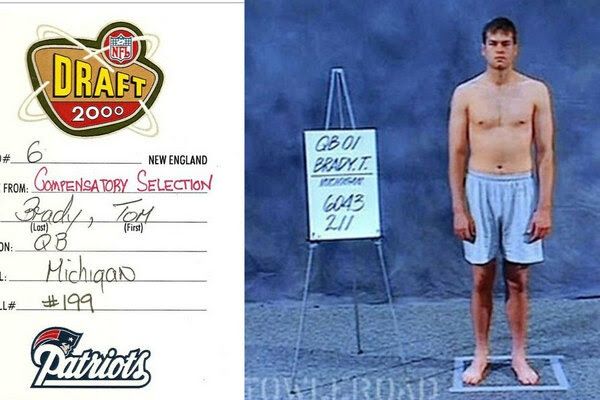
More than two decades later, Touchdown Tom is still terrorizing the league. He threw for a career high 5,316 yards last season at the age of 44. He attempted 719 passes and completed 67.5% of them. Touchdowns? There were many: 43, with only six interceptions.
And so, as we enter the 2022 NFL season, Tom Brady is still playing football in this gosh durn league. His 23rd season at quarterback.
In Brady’s early days, NFL offenses were built on establishing the run. Then something changed. It wasn’t the incoming crop of elite quarterbacks, as the league had seen plenty over the years. Maybe it was the Moneyball effect or the rise of analytics.
Whatever it was, as Brady entered the second decade of his playing career, this much was clear: if you wanted to compete, if you wanted to win Super Bowls, you had to pass — and you had to pass a lot.
Or at least, you had to pose the threat of passing it a lot. There are still offenses in 2022 that seem hellbent on establishing the run — hello again, Pete Carroll — but by and large, most NFL front offices are looking for a signal caller that can keep their team in a rendezvous with the Patrick Mahomeses and Josh Allenses of the league.
NFL fans seem to agree. We bemoan offenses that begin a series with two straight runs; those that opt for a draw on third-and-long. Passing rocks and we want more of it. More often, earlier, always.
So why hasn’t fantasy football caught up?
There is no way we should be starting two running backs in fantasy football as we enter Tommothy Brady’s 23rd season.
It no longer makes sense.
Rushing vs. Passing in the 21st Century
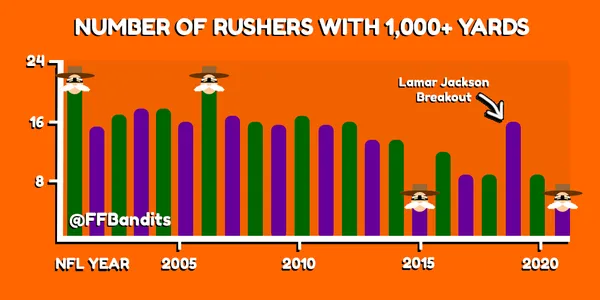
- Twice: Number of times 20+ backs have hit the 1,000+ yard rushing mark (2000 and 2006)
- 2013 Was the Turning Point: 13 or fewer backs have eclipsed 1,000 rushing yards since 2013 — with one exception: 2019 saw 16 ball carriers rush for more than a thousand yards.
- 2006, 2019, 2020: Years in which a QB rushed for more than 1,000 yards. Michael Vick in 2006 and Lamar Jackson in 2019 & 2020.
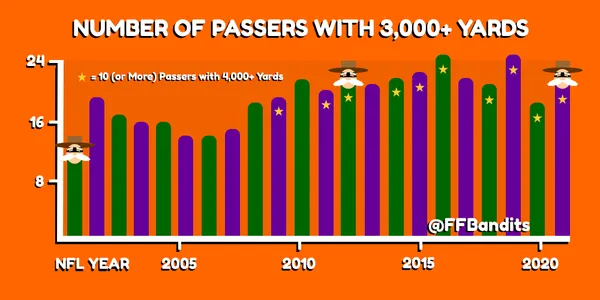
- Since 2010, there have been 20+ quarterbacks who have eclipsed 3,000 yards in every season (with the exception of the 2020 pandemic season that saw 18 pass the mark).
- 4,000+ Passing Yards: 10 or more quarterbacks have passed for 4,000+ yards 10 times since the 2009 season.
Want an RB1 That Will Rush for 1,000 Yards? Good Luck
- 7 RBs with 1,000 or more yards (2015)
- 12 RBs with 1,000 or more yards (2016)
- 9 RBs with 1,000 or more yards (2017)
- 9 RBs with 1,000 or more yards (2018)
- 15 RBs with 1,000 or more yards (2019)
- 8 RBs with 1,000 or more yards (2020)
- 7 RBs with 1,000 or more yards (2021)
Even in smaller fantasy leagues, where eight managers duke it out for the chip, it’s become harder to land a running back that will produce like those of yore.
Some running backs are making up for their lack of rushing with receiving work. More often than not, though, wide receivers are reaping the benefits of this new, pass-happy NFL — and the proliferation of three-wide sets.
The Rise of 11 Personnel
Thanks to the folks at Sharp Football Analysis for compiling how often NFL offenses trot out three wide receivers, one running back, and one tight end.
Folks, it’s a lot:
2018–2021 NFL 11 Personnel Usage
- 2018: 65% of total plays
- 2019: 60% of total plays
- 2020: 60% of total plays
- 2021: 61% of total plays
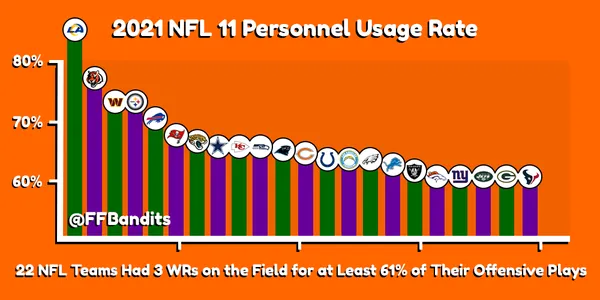
The Super Bowl champion Los Angeles Rams led the league with three wide-receiver sets on a whopping 86% of their offensive plays. The Super Bowl runner-up Cincinnati Bengals finished second, running 11 personnel on 77% of their offensive plays.
Ten playoff teams used 11 personnel on the majority of their offensive snaps. The four that didn’t? The Arizona Cardinals (#5 seed), New England Patriots (#6 seed), San Francisco 49ers (#6 seed), and King Henry’s Tennessee Titans (#1 seed).
How did 11 personnel affect fantasy scoring?
If we look at how the Top 100 FLEX players finished the 2021 fantasy football season, here’s how things shook out:
- PPR Scoring: 67 of the Top 100 FLEX players came from teams that predominantly ran 11 personnel.
- Half-PPR Scoring: 68 of the Top 100 FLEX players came from teams that predominantly ran 11 personnel.
- Standard Scoring: 65 of the Top 100 FLEX players came from teams that predominantly ran 11 personnel.
- Yahoo! Scoring: 65 of the Top 100 FLEX players came from teams that predominantly ran 11 personnel.
- ESPN Scoring: 65 of the Top 100 FLEX players came from teams that predominantly ran 11 personnel.
How about quarterbacks? The top nine played for teams that ran 11 personnel more often than not.
Committee Backfields Aren't Going Anywhere
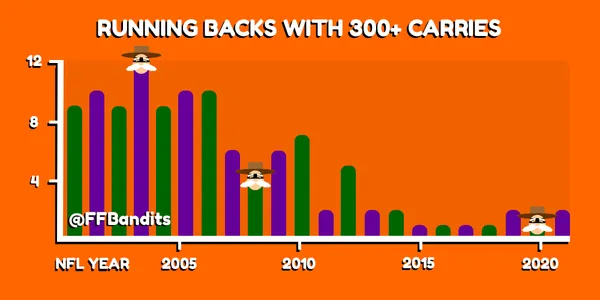
Can you believe Eddie George and Larry Johnson eclipsed 400 carries this century? Derrick Henry was on pace in 2021 before going down with an injury in Week 8.
But as you can see, since about 2010… RBs simply aren’t getting 300+ rushing attempts. And NFL front offices aren’t prioritizing the position in the draft.
19 running backs have been taken in the first round since 2010.
32 running backs were taken in the first round from 2000-2009. Three running backs — Ronnie Brown, Cedric Benson, and Cadillac Williams — were taken in the top five picks in the 2005 NFL Draft.
Fast-forward 17 years.
April 29, 2022 — Las Vegas, Nevada
The Raiders decline RB Josh Jacobs’s fifth-year option.
After rushing for more than 1,000 yards in each of his first two seasons as a pro—earning P.F.W.A. Rookie of the Year honors and a Pro Bowl invite in 2020—Jacobs saw fewer rushing attempts in 2021 and finished with 872 yards on the ground.
With a new regime in place for 2022, they declined to pick up the 2019 first-round pick’s option — and it wouldn’t be a surprise if this was the beginning of the new normal across the NFL.
Saquon Barkley had his fifth-year option picked up last season, but that was before new HC Brian Daboll and GM Joe Schoen got to town.
Rashaad Penny didn’t have his option picked up by the Seahawks, but they did give him a 1-year contract with a little more than $5 million guaranteed after his successful stretch to end the 2021 season.
Sony Michel, the 31st pick in the 2018 draft, is already playing for his third team.
What will happen with Clyde Edwards-Helaire, Najee Harris, and Travis Etienne? No running backs were selected in the first round of the 2022 NFL Draft, with Breece Hall and Ken Walker selected in the early second.
With the (rightfully) surging cost of WR contracts this offseason, it seems more likely that running backs in the first round will be a thing of the past… and ultimately, far fewer will receive second contracts with the teams that draft them.
Total Games Played (2021-2018): RB vs. WR
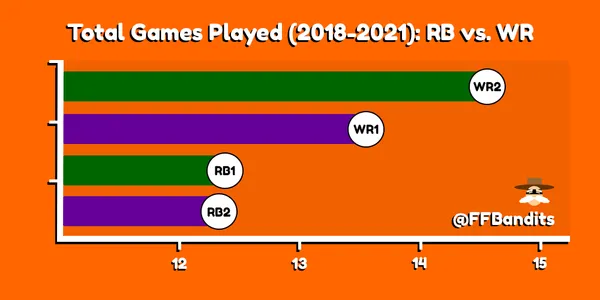
It’s gauche to claim a player is injury prone.
Can we claim a position is injury prone?
It makes sense that running backs are more likely to suffer injuries based on the number of hits they take on any given Sunday. And the numbers back it up.
Here’s how many games the top RBs & WRs played each season, per My Fantasy League ADP:
Total Games Played (2018-2021)
- WR2: 14.56
- WR1: 13.89
- RB1: 12.31
- RB2: 12.26
Based on where they were drafted, the typical WR1 is expected to play at least one more game per season than an RB1. The typical WR2 is expected to play at least two more games per season than an RB2.
Look, folks. We need to get back to loving running backs, OK? I think this is a start.
It’s pretty awesome that the league is passing more than ever and cool to see these insanely talented QBs launch the ball 70 yards.
You know what’s really cool, though? When a running back breaks free for a long touchdown scamper. Ooooooooweeeeee!
I feel like we’ve forgotten that!
All of the data since the turn of the century points to starting one running back and three wide receivers in our fantasy football lineups. It just makes sense.
What the data doesn’t show is that we’ve sort of discounted the position and the players, themselves—the guys—in general, because of their usage decline in NFL offenses and the recent spate of seasons mired with bad injury luck.
If we make the switch to starting 1 RB and 3 WRs not only will our fantasy game improve and finally mirror the modern NFL, but we may even start to love running backs again.
Anyway, enough hooey.
If you’d like to follow the Bandit on Twitter, let me know what you think about switching your league’s roster settings to starting 1 RB and 3 WRs.
Until next time…. Yeeeeeeeeehaw!
